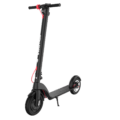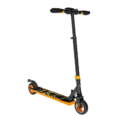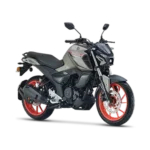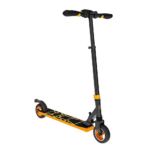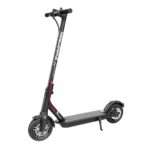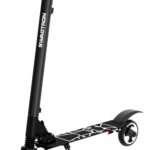- Home
- Scooters
- Electric Scooters
- Swagtron SG-5 Boost
Swagtron SG-5 Boost
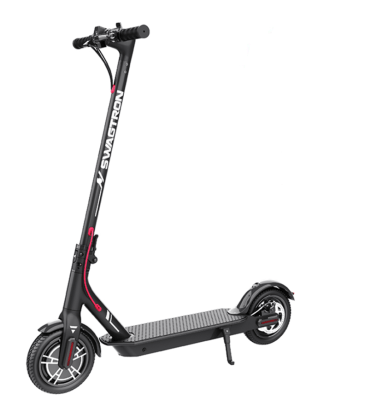


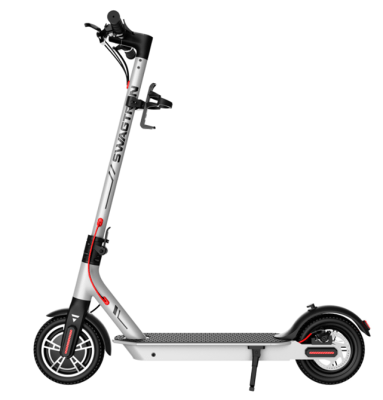
- Battery Range: 11–12 miles (18–19 km)
- Top Speed: 18 mph (29 km/h)
- Motor Power: 300 W
- Weight Capacity: 320 lb (145 kg)
- Charging Time: ~3.5 h
- Scooter Weight: 26.0 lb (11.8 kg)
PROS
- 18 mph (29 km/h) top speed for class
- Honeycomb 8.5″ tires (no flats)
- Rear disc + electronic braking
- Bluetooth app with cruise control
- Quick 1-click folding
- LED headlight and rear brake light
CONS
- Short real-world range
- No suspension
- Battery capacity not disclosed
- IP rating not specified
Key Takeaways
- The Swagtron SG-5 Boost is an entry-level scooter with a 300-watt motor, foldable design, and no-flat honeycomb tires.
- It features straightforward controls, three speed modes, and cruise control, making it user-friendly for new riders.
- With a weight limit of 320 lb and a range of up to 11 miles, it’s ideal for short commutes and errands.
- The scooter offers solid braking, basic lights, and a battery management system for safety during rides.
- The Swagtron SG-5 Boost suits casual users and students but is less effective on steep hills and long distances.
Table of contents
- What Is the Swagtron SG-5 Boost?
- How the Swagtron SG-5 Boost Works
- Key Specifications
- Design & Build Quality
- Performance Fundamentals
- Battery, Range & Efficiency
- Ride Quality & Comfort
- Braking & Safety Features
- Portability & Daily Usability
- Maintenance & Care
- Weather & Seasonal Considerations
- Swagtron SG-5 Boost vs Alternatives
- Who the Swagtron SG-5 Boost Is (and Isn’t) For
The Swagtron SG-5 Boost is a simple, city-ready scooter for short hops and daily errands. It favors steady power, no-flat tires, and a quick fold, so you spend less time fiddling and more time rolling. If you want low fuss and a fair price, the Swagtron SG-5 Boost hits a sweet spot.
What Is the Swagtron SG-5 Boost?
This model lives in the entry commuter class, and it owns that role. You get a 300-watt front-hub motor, a 37-volt lithium-ion battery, and 8.5-inch honeycomb tires that shrug off flats. The battery sits in the deck, the motor sits in the front wheel, and the frame is aluminum. The folding joint uses a latch and collar that lock to a small hook on the rear fender. Rider capacity tops out at 320 lb (145 kg), and the scooter weighs about 26 lb (11.8 kg), so most people can carry it up a few steps without much effort.
Controls stay simple, which helps new riders. The right thumb throttle feeds power. The left hand runs a single brake lever and a bell. A small LED display shows speed and battery bars. You can switch among three speed modes, and you can hold a steady pace with cruise control.
How the Swagtron SG-5 Boost Works
Think of three systems that talk to each other, then keep the ride smooth.
Motor and controller. The 300-watt hub pulls up to a listed 18 mph (29 km/h). You press the thumb lever and the controller meters current to the motor. Higher modes allow more top speed, and lower modes trim it for busy paths. The feel is friendly rather than punchy, which helps balance at low speed.
Battery and charging. A 37 V, 270 Wh pack lives in the deck. You plug a 42 V, 2 A charger into the port on the left side, then wait about 3.5 hours for a full charge. The battery management system handles balance, over-charge, under-voltage, overheating, and auto shutoff. In plain words, the pack looks after itself while you ride and while you charge.
Brakes and lighting. One hand lever controls the rear brake and cuts motor power at the same time, so stops feel calm instead of grabby. The headlight sits on the stem, and the rear light brightens when you brake. You can ride at dusk, yet a helmet light helps when streets get darker.
Key Specifications
| Block | Item | Details |
|---|---|---|
| General | Frame | Aluminum alloy, front-hub motor, deck-mounted battery |
| Rider height | 4’–6’6” (120–200 cm) | |
| Rider weight limit | 44–320 lb (20–145 kg) | |
| Performance & Power | Motor | 300 W front hub |
| Top speed | Up to 18 mph (29 km/h) | |
| Claimed range | Up to 11 mi (17.7 km) per charge | |
| Battery, Charging & Electrical | Battery | 37 V, 270 Wh lithium-ion, BMS with balance, over-charge, under-voltage, overheat, auto shutoff |
| Charger | 42 V, 2 A (input 100–240 V, 50/60 Hz) | |
| Charge time | ~3.5 hours to full | |
| Build & Dimensions | Tires | 8.5 in (216 mm) air-less honeycomb, front motorized, rear passive |
| Unfolded size | 41.5 × 17 × 45.3 in (1054 × 436 × 1150 mm) | |
| Folded size | 41.5 × 17 × 19 in (1054 × 436 × 480 mm) | |
| Weight | About 26 lb (11.8 kg) | |
| Safety & Control | Brakes | Rear mechanical brake with motor cut-off, single left lever |
| Lights | LED headlight on stem, rear light with brake activation | |
| Water exposure | No formal IP rating in the manual, treat as splash-only | |
| Features & Extras | Display | Speed and battery level |
| Speed modes | Three selectable modes | |
| Cruise Control | Yes | |
| App | iOS/Android support for basic controls and status | |
| Included | Bell, kickstand, bottle holder | |
| Warranty & Compliance | Warranty | 90-day limited hardware warranty (US/Canada) |
| Compliance | FCC Part 15 device |
These specifications come from the official manual for the SG-5 Boost, and they match the maker’s listed numbers for speed, range, size, and battery ratings.
Design & Build Quality
The look is clean, and the parts feel tidy in hand. The stem is straight, the deck is flat, and the wiring is routed with simple, visible runs. The latch folds down, a collar locks the joint, and a hook on the fender catches the stem when folded. The matte finish resists scuffs, and the deck rubber grips well even with damp soles.
The battery sits low in the deck, so plan around big curbs and tall speed bumps. The housing is robust, yet it can scrape if you take steep obstacles at speed. Slow a touch, then roll over at a shallow angle. You will protect the pack shell, and the scooter will feel calmer.
Handlebar width lands in a comfort zone for most riders. The grips have a light texture. The bell sits close to the brake lever, and the display is easy to read in shade. Midday sun can wash it out a bit, so tilt your head to catch the readout. If you ride with gloves in winter, try the throttle throw while stopped, then adjust your grip until it feels natural.
Fit and finish line up with the class. The latch snaps shut with a firm click, and the collar threads cleanly. Hinge play stays small when locked. Check the collar after your first few rides, then check it weekly. A drop of light oil on the latch pin every few months keeps the action smooth.
Performance Fundamentals
Starts and acceleration. In top mode the SG-5 Boost moves off the line with a steady pull, then builds speed without drama. This helps balance in crowds, and it keeps the front wheel from skipping on painted lines. Mid mode works well on bike paths, and low mode keeps your pace calm on narrow sidewalks.
Cruising stability. The long, low deck plants the scooter at speed, and the honeycomb tires track straight on clean pavement. You feel more surface texture than with air-filled tires, yet the scooter holds a line. The stem shows a bit of flex if you rock it on purpose, then it settles once you ride straight. Stay loose in the knees and the chassis will feel more relaxed.
Hills. Short hills in the 7–10% range slow the scooter. So give yourself a rolling start when you can. A light rider will crest smaller grades at a fair pace, and a heavier rider will see a lower speed. Pick bike lanes when a road tilts up, then take smoother lines that avoid the steepest blocks.
Battery, Range & Efficiency
The 37 V, 270 Wh pack is rated for up to 11 miles (17.7 km) per charge. Real range moves with rider weight, wind, surface, and temperature. A 150 lb rider on flat paths in mild weather can stay near the listed figure at 10–12 mph in mid mode. A 200 lb rider on rough streets in cold air will see less.
So plan with a buffer. For a 5 mile round trip, charge to full, then ride in mid mode where traffic allows. You will get home with a safe reserve. For longer loops, park near an outlet at lunch and top up for about an hour. A 42 V, 2 A charger adds a useful chunk in a short break. If you want even more life from the pack, check this practical guide on how to extend the battery life of your electric scooter, then build a few habits you can stick with.
Simple care helps the pack age well. Avoid leaving the scooter at 100% for weeks. End day-to-day rides around half to three-quarters. Charge to full the night before a longer ride. Bring the scooter indoors during heat waves and cold snaps. Store it between -4°F and 140°F (-20°C to 60°C), yet aim for a cool, dry room. If the deck feels hot after a long climb, let it cool before you plug in.
Ride Quality & Comfort
Honeycomb tires never need air, and you never fix flats. The trade-off is a firmer feel over cracks and seams. Grip is solid on clean pavement, and it stays decent on compact paths. On broken asphalt, bend your knees and let your legs do the suspension work. Stand a bit farther back over larger cracks so the front wheel can rise.
Deck space fits a staggered stance. Place your front foot near the front of the deck, then angle your back foot near the rear. This shortens your body and calms steering inputs. The bar height suits most riders from about 5’2” to 6’2”. Very tall riders might wish for more height, yet the neutral posture still feels fine for short city trips. If your hands get sore on long rides, try gel grips or padded gloves.
The cockpit is basic but clear. The thumb throttle moves with moderate effort, and the brake lever bites with confidence after a half pull. The headlight reaches far enough for dusk rides on familiar streets. Add a brighter bar light for rural paths or dark neighborhoods, then check that the rear light remains visible past your backpack straps.
Braking & Safety Features
The rear brake gives smooth, predictable stops. Pull early and squeeze rather than grab. The motor power cuts as you brake, so the scooter does not fight you. Practice two or three quick stops in an empty lot, then ride with a rule. If you move near cars or cross busy paths, cover the lever at speed so your reaction time stays short.
Lights cover the basics. The stem headlight helps you see and be seen, and the rear light brightens under braking. Snap-on reflectors on your helmet or bag add even more pop in traffic. A reflective ankle band moves as you push off and tends to catch a driver’s eye.
The battery management system includes safety cutoffs. Over-charge, under-voltage, overheat, and auto shutoff protect the pack. This does not replace good habits. Charge on a hard surface, keep the port dry, and avoid leaving the scooter on the charger for days. If the charge light stays red long past normal, unplug, wait, then try again.
The manual does not list an IP rating, so treat the scooter as splash-only. Light drizzle is fine at low speed, but avoid heavy rain, deep puddles, and power washing. Dry the deck and port after wet rides. If the charging port is damp, hold off on charging until it is fully dry. Road salt can corrode contacts, so wipe the area after winter rides.
Portability & Daily Usability
At about 26 lb (11.8 kg), the SG-5 Boost is easy to shift around. The fold takes seconds. Flip the latch, twist the collar, drop the stem, then hook it to the rear fender. The folded size is 41.5 × 17 × 19 in (1054 × 436 × 480 mm), so it fits in most trunks and under desks. The bar ends sit low when folded, which means they catch sleeves less often.
Plan your carry path before stairs. Hold the stem near the hinge and keep the deck against your leg for leverage. Take a break at landings if the flight is long. If you lift into a rack, bend your knees and keep the scooter close to your body. For station walks, pull it by the stem like a small suitcase, then keep the rear wheel behind you so it does not clip your heels.
Daily use stays simple. The display shows speed and battery. Three modes give you control in parks and bike lanes. Cruise control helps on long, straight paths. The kickstand holds steady on flat ground. Store the scooter in a dry room. Keep a spare charger at work if your route lands near the rated range.
Maintenance & Care
A small routine keeps the scooter quiet and safe.
Before each ride. Check the latch and collar. Squeeze the brake and confirm strong bite. Look over the tires for cuts or lodged debris. Confirm the headlight and rear light work. Spin the rear wheel and listen for rotor rub.
Weekly. Inspect hinge play, then re-tighten the collar if needed. Wipe the deck and stem with a damp cloth. Check for loose screws at the brake, fender, and display. Clean dust from the charging port area. Listen for scraping at the rear rotor and adjust if you hear it.
Monthly. Clean the rear rotor with isopropyl alcohol. Check pad wear. Inspect the charger cable for nicks. Tighten kickstand screws. Review your charge habits and keep them steady.
App and firmware. Pair the scooter to the app for speed and status. Install firmware updates when offered, then let the process finish without interruptions. If pairing fails, cycle scooter power and try again with the phone next to the display.
Storage. For breaks longer than a month, store the battery around 50–70%. Top it up for about 30 minutes every two to three months. Keep the scooter in a cool, dry place away from direct sun, heaters, and damp corners. Leave space around it so air can move.
Weather & Seasonal Considerations
Rain. Light rain at slow speed is manageable, and you should brake earlier since water lengthens stopping distance. Use a bright headlight and add a helmet light for depth. Drag the rear brake lightly after puddles to dry the rotor.
Heat. Hot days stress batteries and motors. Park indoors and out of the sun. If the deck feels hot after a ride, let it cool before charging. Pace climbs on very warm days, then give the scooter a short rest at the top.
Cold. Cold air lowers range. Start with a full charge, ride in mid mode, and warm the scooter indoors before charging. Use gloves with grip texture so your throttle hand stays steady.
Debris and grit. Honeycomb tires resist punctures, yet they still slide on loose sand and wet leaves. Scan far ahead, pick clean lines, and slow for painted crosswalks when wet. Wipe grit from the deck so your stance stays secure.
Swagtron SG-5 Boost vs Alternatives
Entry commuters with air-filled tires ride softer, yet they add tube checks and the risk of flats. Honeycomb tires remove those chores, and they keep rolling over glass that would sideline a tube. If your route runs on clean pavement, this trade makes sense. If you face broken asphalt every day, a pneumatic setup may feel kinder to your hands.
Do you want a bit more punch from stops and a touch more spec headroom? Then take a look at the Swagtron 5T. It sits near the same family, and it nudges power and features upward. Bigger, faster scooters exist of course, yet they weigh more, cost more, and demand longer charge windows.
Trail-focused models bring suspension, knobby tires, and heavy frames. They shine off road, then feel awkward on stairs and in small apartments. The SG-5 Boost fits better for tilt-and-carry use and mixed city paths.
Who the Swagtron SG-5 Boost Is (and Isn’t) For
Great for.
- Short commutes up to about 5–7 miles round trip
- Students who need a light, packable ride for campus
- Last-mile riders who pair with buses or trains
- Casual riders who want no-flat tires and a quick fold
Not ideal for.
- Routes with long, steep hills
- Riders who want a plush feel on broken pavement
- Daily range needs above 12–15 miles
- Night riders who need very strong lighting from the start
If you live in the first group, the SG-5 Boost delivers steady speed and low fuss. If your rides change later, you can step up in class without learning a new way to ride.
Specifications
General
| Model The Model specifies the exact version or name of the scooter. It helps identify its unique design, features, and specifications within the manufacturer’s product line. Knowing the model makes it easier to compare options, find compatible accessories, or look up support information. | SG-5 Boost |
| Brand The Brand identifies the manufacturer or company that designs and produces the scooter. A trusted brand is a sign of quality, reliability, and good customer support. Well-known brands often have higher standards for safety, performance, and after-sales service, giving you more confidence in your purchase. | Swagtron |
| Release Date The Release Date indicates when the scooter model was officially launched on the market. This helps you know how current the design, technology, and features are. A newer release date often means updated components, improved performance, and the latest safety or smart features. | 18 November 2025 |
| Recommended Age Recommended Age indicates the minimum age range that the scooter is designed for, based on safety, size, and ease of use. Following the recommended age helps ensure that riders can handle the scooter’s speed, weight, and controls comfortably and safely. Always check local laws and use protective gear, especially for younger riders. | +16 |
Performance & Power
| Motor Power (Wattage) What it means: The motor power, measured in watts (W), shows how strong the scooter’s electric motor is. Why it matters: Higher wattage usually means better acceleration, more torque, and improved performance on hills or rough terrain. For example, a 250W motor is good for flat city roads and light riders, while a 500W or 1000W motor provides more power for faster speeds or climbing steep inclines. | 300 W front hub motor |
| Top Speed The Top Speed indicates the maximum speed that the scooter can reach under optimal conditions. It’s usually measured on level ground with a fully charged battery and an average rider weight. A higher top speed allows you to travel longer distances faster, but always ensure you ride within legal speed limits and your personal comfort zone for safety. | 18 mph (29 km/h) |
| Battery Capacity Battery Capacity refers to the total amount of energy the scooter’s battery can store, usually measured in ampere-hours (Ah) or watt-hours (Wh). A higher battery capacity means you can ride longer distances on a single charge, reducing the need for frequent recharging. Keep in mind that actual range can vary depending on rider weight, terrain, speed, and weather conditions. | 37 V — Not specified Ah (Not specified Wh) |
| Estimated Range per Charge The Estimated Range per Charge indicates the average distance the scooter can travel on a single full battery charge. This range is calculated under optimal conditions, such as flat terrain, moderate speed, and average rider weight. Real-world range may vary depending on riding style, terrain, weather, and load. A longer range means fewer recharges and greater freedom for longer trips. | 11–12 miles (18–19 km) |
| Hill Climb Ability Hill Climb Ability describes the maximum incline or slope that the scooter can handle while maintaining stable performance. It’s typically expressed as a percentage or in degrees. A higher hill climb rating means the scooter can tackle steeper hills without losing too much speed or power. Actual climbing performance may vary based on rider weight, battery charge, and terrain conditions. | Not specified |
| Drive System The Drive System refers to how power from the motor is delivered to the wheels. Electric scooters typically use either a hub motor (directly integrated into the wheel) or a chain/belt drive system. A high-quality drive system ensures smooth acceleration, efficient power transfer, and low maintenance. The choice of drive system affects performance, noise level, and overall ride experience. | Front hub (FWD) |
Charging & Electrical
| Charging Time Charging Time indicates how long it takes to fully recharge the scooter’s battery from empty to 100% using the standard charger provided. Faster charging means less downtime and more time on the road. Actual charging time may vary slightly depending on battery capacity, charger output, and environmental conditions. | Approx. 3.5 hours |
| Battery Type Battery Type refers to the specific technology used in the scooter’s battery, which affects performance, lifespan, weight, and charging time. Most modern electric scooters use high-quality lithium-ion (Li-ion) batteries because they offer a good balance of energy density, durability, and low maintenance. A reliable battery type ensures consistent power delivery and longer riding ranges. | Lithium-ion pack with BMS |
| Removable Battery A Removable Battery means the battery pack can be easily detached from the scooter for convenient charging and replacement. This feature allows you to charge the battery separately, swap it with a spare for extended range, or securely store it indoors in extreme weather. Removable batteries add flexibility and make it easier to keep your scooter powered up wherever you are. | Non-removable internal battery (fixed pack) |
| Regenerative Braking Regenerative Braking is an energy-saving feature that converts some of the energy normally lost during braking back into battery power. When you slow down or brake, the motor works in reverse to generate electricity, which helps extend the scooter’s range and improves overall efficiency. This system also reduces wear on traditional brake components, leading to lower maintenance over time. | Yes (via electronic brake) |
| Lighting Lighting refers to the built-in front and rear lights that enhance visibility and safety when riding in low-light conditions or at night. Good lighting helps you see the road ahead and ensures that other road users can see you. Many scooters include LED headlights, taillights, and sometimes brake lights or side reflectors for added safety and compliance with local traffic regulations. | LED headlight + rear LED/brake + reflectors |
Build & Dimensions
| Scooter Weight Scooter Weight refers to the total weight of the scooter when fully assembled, including the battery. This affects how easy it is to carry, lift, and store the scooter when not in use. A lighter scooter is more portable and convenient for commuting, especially if you need to carry it upstairs or onto public transport. Keep in mind that a sturdy frame and quality components may add to the weight but also contribute to better durability and ride stability. | 26.0 lb (11.8 kg) |
| Maximum Rider Weight Maximum Rider Weight indicates the highest rider weight that the scooter is designed to safely support while maintaining optimal performance and stability. Staying within this limit helps ensure reliable acceleration, braking, and climbing ability, and it protects the frame, suspension, and motor from excessive strain. Exceeding the recommended limit may reduce performance and increase wear on components. | 320 lb (145 kg) |
| Deck Size Deck Size refers to the dimensions of the scooter’s standing platform. A wider and longer deck provides more foot space, allowing you to stand comfortably and adjust your stance while riding. A well-sized deck improves balance and stability, especially on longer rides or at higher speeds. Compact decks, on the other hand, help keep the scooter lightweight and portable. | Low deck commuter geometry; compact footprint |
| Handlebar Height Handlebar Height refers to the distance from the deck to the handlebars, which affects your riding posture and comfort. An appropriate handlebar height helps you maintain good balance, reduces strain on your back and arms, and makes steering more comfortable. Some scooters have adjustable handlebars to fit riders of different heights, while others have a fixed height for a streamlined design. | Fixed |
| Folding Mechanism The Folding Mechanism describes how easily and securely the scooter can be folded for carrying and storage. A well-designed folding system lets you quickly collapse the scooter into a compact size, making it convenient to transport on public transit, store under a desk, or fit into a car trunk. Look for sturdy latches and safety locks to ensure the scooter stays firmly in place when folded or unfolded. | 1-click quick fold latch |
| Dimensions Folded Dimensions indicate the size of the scooter when it’s fully folded. This measurement shows how much space the scooter will take up when stored or carried, making it easier to check if it will fit in your car trunk, under a desk, or in a closet. Compact folded dimensions are ideal for commuters who need to bring their scooter on public transport or store it in tight spaces. | Unfolded: 41.5 × 17 × 45.3 in (105.4 × 43.2 × 115.1 cm); Folded: 41.5 × 17 × 19 in (105.4 × 43.2 × 48.3 cm) |
| Material Material refers to the primary construction materials used for the scooter’s frame and key components. High-quality materials like aircraft-grade aluminum, reinforced steel, or durable composites provide strength, stability, and a lighter overall weight. A sturdy material ensures the scooter can handle daily wear and tear while maintaining safety and performance. | Aluminum alloy |
Safety & Control
| Brake Type(s) Brake Type(s) describe the braking systems the scooter uses to help you slow down or stop safely. Common brake types include mechanical brakes (like drum or disc brakes), electronic brakes, and foot brakes. Many scooters combine multiple braking systems for added safety and shorter stopping distances. The type and quality of brakes affect your control, especially when riding at higher speeds or on slopes. | Front electronic + rear disc + foot brake |
| Suspension Suspension refers to the system that absorbs shocks and vibrations while riding, providing a smoother and more comfortable ride over uneven or rough surfaces. Scooters may have front suspension, rear suspension, or dual suspension for better shock absorption and stability. Good suspension helps reduce rider fatigue and improves control, especially when riding on bumpy roads or off-road paths. | None |
| Tire Type Tire Type refers to the kind of tires the scooter uses, which directly affects ride comfort, traction, and maintenance. Common types include solid (airless) tires, pneumatic (air-filled) tires, or hybrid options. Pneumatic tires offer better shock absorption and a smoother ride on rough surfaces, while solid tires are puncture-proof and require less upkeep. The right tire type helps ensure safe handling and a comfortable ride in different conditions. | 8.5″ honeycomb solid |
| Tire Size Tire Size indicates the diameter and width of the scooter’s tires, which affect ride comfort, stability, and how well the scooter handles different terrains. Larger tires generally offer better shock absorption and a smoother ride over bumps and rough surfaces, while smaller tires keep the scooter lighter and more portable. Choosing the right tire size helps ensure a balance between agility and comfort. | 8.5-inch |
| Kickstand The Kickstand is a built-in stand that allows you to park your scooter upright when it’s not in use. A sturdy kickstand keeps the scooter stable and prevents it from tipping over, protecting it from scratches and damage. It also makes storing and accessing your scooter more convenient, whether you’re at home, work, or on the go. | Side kickstand |
| Water Resistance Rating Water Resistance Rating indicates how well the scooter is protected against water and moisture, usually shown as an IP (Ingress Protection) rating. This rating helps you understand whether the scooter can handle light rain, splashes, or wet roads without damage. While most scooters are not fully waterproof, a good water resistance rating adds peace of mind when riding in changing weather conditions. Always avoid deep puddles or submerging the scooter to protect its electrical components. | Not specified |
Features & Extras
| Display/Console The Display (or Console) shows important real-time information about your ride, helping you monitor your scooter’s status at a glance. Typical displays show speed, battery level, distance traveled, and riding mode. Some models also include additional features like Bluetooth connectivity, app integration, or backlighting for better visibility at night. A clear and easy-to-read display enhances safety and convenience on every trip. | LED display with speed, battery, mode |
| Ride Modes Ride Modes refer to the different speed and power settings you can choose to match your riding style or road conditions. Common modes include eco for maximum range and energy efficiency, standard for everyday balance, and sport or turbo for higher speed and stronger acceleration. Switching between ride modes allows you to customize performance, conserve battery, and ride safely in various environments. | 3 modes (Eco/Standard/Sport) |
| Smart App Connectivity Smart App Connectivity lets you pair your scooter with a dedicated mobile app via Bluetooth. Using the app, you can monitor real-time ride stats like speed, battery level, and range, adjust settings such as ride modes or cruise control, lock the scooter for added security, and sometimes receive firmware updates. This feature adds convenience and allows you to personalize your riding experience right from your smartphone. | Swagger app (Bluetooth): lock, modes, stats |
| Anti-Theft System The Anti-Theft System helps protect your scooter from unauthorized use or theft. This feature can include built-in alarms, electronic motor locks, GPS tracking, or remote locking through a mobile app. A good anti-theft system provides peace of mind when parking your scooter in public spaces, adding an extra layer of security to safeguard your investment. | App lock |
| Cruise Control Cruise Control allows you to maintain a steady speed without continuously holding the throttle. This feature makes longer rides more comfortable by reducing hand fatigue and providing a smoother, more relaxed riding experience — especially on flat, open roads or bike lanes. For safety, cruise control can usually be easily activated or deactivated while riding. | Yes (cruise control) |
| Accessories Included Accessories Included lists the additional items that come with the scooter to enhance your riding experience and convenience. Common accessories may include a charger, kickstand, bell, lights, phone holder, or carrying strap. These extras add value by making your scooter safer, easier to use, and ready to ride straight out of the box. | Scooter, charger (42 V, amperage not specified), tools, manual |
Warranty & Compliance
| Warranty Period The Warranty Period indicates how long the manufacturer guarantees the scooter against defects in materials and workmanship under normal use. A good warranty provides peace of mind, showing the brand’s confidence in its product quality. Always check what parts are covered, such as the frame, battery, and motor, and follow the maintenance guidelines to keep your warranty valid. | 12 months (region-dependent) |
| Certifications Certifications confirm that the scooter meets specific safety, quality, and environmental standards set by recognized organizations or regulatory bodies. Common certifications may include CE, RoHS, UL, or other local compliance marks, depending on your region. These certifications ensure that the scooter is manufactured to high standards and is safe and legal to use in your country. | Local micromobility regulations |


